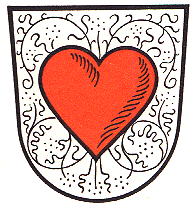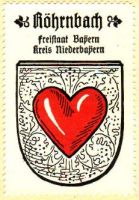Röhrnbach: Difference between revisions
Jump to navigation
Jump to search
Knorrepoes (talk | contribs) m (Text replacement - "{{de}}" to "") |
Knorrepoes (talk | contribs) No edit summary |
||
| Line 1: | Line 1: | ||
{| class="wikitable" | |||
|- style="vertical-align:top;" | |||
|[[File:rohrnbac.jpg|center|350 px|alt=Wappen von {{PAGENAME}}/Arms (crest) of {{PAGENAME}}]] | |||
| | |||
'''Country''' : Germany [[File:germany.jpg|60 px|right]]<br><br><br> | |||
'''State''' : [[Bayern]][[File:Bayern.jpg|60 px|right]]<br><br><br> | |||
'''District (Kreis)''' : [[Freyung-Grafenau]] (until 1973 [[Wolfstein (kreis)|Wolfstein]])[[File:Freyungg.kreis.jpg|60 px|right]]<br><br><br> | |||
'''Additions''':<br> | |||
* 1971 Oberndorf | |||
* 1971 Wilhelmsreut | |||
* 1976 Außernbrünst | |||
|} | |||
{| class="wikitable" | {| class="wikitable" | ||
| Line 13: | Line 17: | ||
|- | |- | ||
|'''German''' | |'''German''' | ||
| | | In Silber ein rotes Herz. | ||
In Silber ein rotes Herz. | |||
|- | |- | ||
|'''English''' | |'''English''' | ||
| | | Argent, a heart Gules. | ||
|} | |} | ||
===Origin/meaning=== | ===Origin/meaning=== | ||
The arms probably date from the latter part of the | The arms probably date from the latter part of the 19th century. | ||
The village belonged to 1803 to [[Passau]] and there are no historical arms or seals known. The heart was in 1890 explained to symbolise the 'good hearts' of three local nobles, Jörg Watzmannsdorfer, Burkhard Puchberger and Ulrich Schätzl, who saved the village during a famine in 1459. During 7 months they distributed foods in front of the local church. It is unlikely though that the heart is taken from this story. The origin thus remains unknown. | |||
<gallery widths=250px heights=200px perrow=0> | |||
File:rohrnbach.hagd.jpg|alt=Wappen von Röhrnbach/Arms (crest) of Röhrnbach|The arms by [[Otto Hupp|Hupp]] in the [[Kaffee Hag albums]] +/- 1925 | |||
File:Röhrnbachp.jpg|alt=Wappen von Röhrnbach/Arms (crest) of Röhrnbach|Postal cancellation | |||
</gallery> | |||
[[Civic Heraldry Literature - Germany|'''Literature''']]: Stadler, 1964-1971, 8 volumes. | [[Civic Heraldry Literature - Germany|'''Literature''']]: Stadler, 1964-1971, 8 volumes. | ||
{{de1}} | {{de1}} | ||
Revision as of 05:35, 5 March 2023
|
Country : Germany State : Bayern District (Kreis) : Freyung-Grafenau (until 1973 Wolfstein) Additions:
|
| German | In Silber ein rotes Herz. |
| English | Argent, a heart Gules. |
Origin/meaning
The arms probably date from the latter part of the 19th century.
The village belonged to 1803 to Passau and there are no historical arms or seals known. The heart was in 1890 explained to symbolise the 'good hearts' of three local nobles, Jörg Watzmannsdorfer, Burkhard Puchberger and Ulrich Schätzl, who saved the village during a famine in 1459. During 7 months they distributed foods in front of the local church. It is unlikely though that the heart is taken from this story. The origin thus remains unknown.
The arms by Hupp in the Kaffee Hag albums +/- 1925
Literature: Stadler, 1964-1971, 8 volumes.




